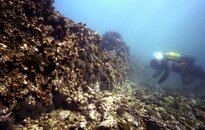For some reason those triangular fin grippers/keepers were called Fixi-Palms — no idea why or if the spelling is even close. They were mandatory since nothing fit.
Fixe-palmes. They were invented and patented in the early 1960s by Beuchat, a diving equipment company in the Mediterranean port of Marseilles, hence the French name. The name "fixe-palmes" derives from "fixer", meaning "to secure", and "palmes", meaning "fins". Fin grips, triangular rubber straps worn over the heel, arch and instep with full-foot fins, remain popular with snorkellers, freedivers and underwater hockey players. The latter frequently opted for fin grips in bright colours:
However, the principal source, the "Rainbow Nation" of South Africa, now only produces them in black. Fin grips are still made in colours other than black in Japan, but sadly they aren't exported to the West.
My own "first time" with scuba was in a swimming pool in my home town of Newcastle upon Tyne in the North East of England in 1970. I had joined the university British Sub-Aqua club at the beginning of the academic year when I began a postgraduate teacher-training course. I wore a pair of British-made Typhoon Rondine full-foot fins, an oval rubber-skirted mask of French manufacture and a Typhoon snorkel with a blue rubber mouthpiece. I had completed my snorkel training at my previous university in the Yorkshire city of Leeds but had never had the time to proceed to scuba because of the heavy workload of my modern foreign languages BA course. I can't remember the name of the regulator (we called them demand valves) supplied by the club, just that it was double-hose. I submerged in the pool under supervision, but surfaced soon afterwards, spluttering. The tank I had been given was very low on air, so my pool dive had to be abandoned. In the event, I never returned because my teacher-training course proved to be even more demanding on my time than my undergraduate course.
I enjoyed my very brief encounter with scuba almost four decades ago, but I've never been tempted to do any water pursuit other than snorkelling since then. I first snorkelled in the late 1950s in those glorious days when public swimming pools permitted youngsters to use masks, fins and snorkels. At school I always preferred academic subjects. I was hopeless at woodwork and team sports and I still can't ride a bike, leading me to believe that I'm probably dyspraxic. Always being the last to be chosen in team sports such as rugby and cricket and showing little talent for athletics either, I was keen to try swimming, especially because the school I attended had its own swimming pool. Swimming lessons seemed to be all about grasping the sides and kicking hard but the skills never translated in my case into swimming for real. I seemed doomed to remain in the shallow end while the vast majority of my classmates swam like fish. Then, one day in the late 1950s, I read about snorkelling and asked my parents to get me a mask, a snorkel and a pair of fins. The fins were pale blue Britmarine Clippers, if I remember correctly, with adjustable heel straps, designed to be worn barefoot, the mask a green Turnbull Australian import and the snorkel a Typhoon aluminium "S"-shape model with a blue mouthpiece on one end and a ping-pong ball valve on the other. The gear was magic. I finally managed to propel myself across the water in the pool without sinking to the bottom, thanks to the fins, while the mask kept the chlorinated water out of my eyes. After a while I found that I was also able to swim without the fins, mask and snorkel, but those items of gear did more for my current ability to swim than kicking at the side ever did.
Since then I've snorkelled in open water in many places around the world, starting in the Mediterranean and an East Berlin lake in the 1970s and graduating to La Jolla Cove near San Diego when I visited California during one of my States-side visits to my brother in Minneapolis. I now confine my snorkelling to the North Sea, 8 miles from where I live, and I'm enjoying the experience more than ever, now I'm in my sixties. I always snorkel with vintage-style gear, full-foot all-rubber fins, oval rubber-skirted mask, "J"-shaped snorkel with a rubber mouthpiece and a valve-less Hydroglove drysuit, every item reminiscent of the time when I began snorkelling, back in the late 1950s. "Something old, something new", as they say about wedding outfits. The same saying can also be true of what we wear in other circumstances. Just because something's new doesn't mean it's necessarily better for everybody!






